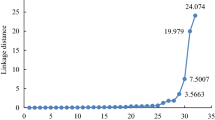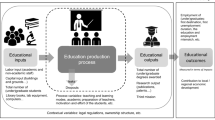Abstract
This paper examined the research efficiency of Chinese higher education institutions with a sample of 105 universities (35 universities in each group of “Project 211”, “Project 985” and general universities). In order to analyze the relative research efficiency among “Project 211”and “Project 985” and general universities, the method of Data Envelopment Analysis (DEA) was implemented with EnPAS software. The result showed that research efficiency of “Project 211” universities was lower than “Project 985” and general universities. Secondly, the research efficiency of the selected universities in China differed by region (eastern, central, western) and the type of universities (polytechnic, comprehensive, others). The implications of this study were presented at the government and university levels. The government should rearrange the financial support programs and evaluation criteria for universities. Universities also need to formulate strategies and systems for efficient operation and performance improvement.


Similar content being viewed by others
Notes
The universities involved in “Project 211” and “Project 985” are also called as Project universities.
References
Bai, X. X., Wang, W. S., & Wei, M. T. (2003). A preliminary study on the evaluation index system of scientific research efficiency in research universities. Journal of Intelligence, 22(1), 33–35.
Baker, A. E. (2011). A data envelopment analysis of the efficiency of higher education institutions using America's best colleges ranking data. Dissertations & Theses: Gradworks, 241(1), 80–88.
Banker, R. D., Cooper, W. W., Seiford, L. M., Thrall, R. M., & Zhu, J. (2004). Returns to scale in different DEA models. European Journal of Operational Research, 154(2), 345–362.
Cha, Y., & Liang, L. (2004). The efficiency evaluation of input-output of colleges and universities based on DEA. Science and Technology Progress and Policy, 21(1), 102–105.
Charnes, A. W., Cooper, W. W., & Rhodes, E. L. (1979). Measuring the efficiency of decision-making units. European Journal of Operational Research, 2(6), 429–444.
Cheng, Y., & Yang, J. (2016). Tracking the academic performance of “Project 985” university through academic ranking of world universities. Evaluation & Management, 14(3), 1–4.
Choi, T. S., Lee, D. W., & Kim, S. H. (2007). Efficiency analysis: Theory and use. Seoul: Seoul Economic Management Press.
Ding, L. (2012). The econometric analysis on the efficiency of universities belonging to MOE under the implementation of “985 Project”. Journal of Higher Education, 33(7), 20–29.
Farrell, M. J. (1957). The measurement of productive efficiency. Journal of the Royal Statistical Society, 120(3), 253–290.
Grosskopf, S., Hayes, K. J., & Taylor, L. L. (2014). Efficiency in education: Research and implications. Applied Economic Perspectives & Policy, 36(2), 175–210.
Gülser, K., & Burak, N. (2006). The relative efficiency of departments at a Turkish engineering college: Data envelopment analysis. Higher Education, 51(2), 173–189.
He, J. (2011). Research on performance evaluation of colleges and universities based on data envelopment analysis. Master's Thesis. Shanxi University of Finance and Economics. Shanxi, China.
Hu, D. X., & Wang, Y. W. (2017). Evaluation of Research Competitiveness of “Project 985” based on DEA. Journal of Beijing Institute of Technology (Social Sciences Edition),19(4). 163–168.
Huang, W. W. (2017). The study on the evaluation of Chinese characteristic education policy-based on the comparison and analysis of “211” “985” “Double First-class” Policy. The Modern Education Journal, 38(6), 2–6.
Huang, J. G., & Yuan, W. C. (2018). Scientific research efficiency evaluation in the construction of world first-class universities. Heilongjiang Researches on Higher Education., 37(8), 11–15.
Lee, J. Y. (2013). Using the DEA method to analyze the university productivity of the human resources industry: The resource development characteristics of the university industry as the center. Master's Thesis. Seoul National University. Seoul, South Korea.
Lee, S. J. (2018). An analysis of Chinese Policy for Establishing the World Class University and the characteristics of ‘Double First-Class University Plan’. Korean Journal of Comparative Education, 28(4), 107–135.
Lee, E. K., & Wu, S. E. (2003). Theory and practice of local government productivity measurement. Seoul: Springer.
Li, L. (2005). Research of universities input and output efficiency basing on DEA. Master’s Thesis. Dalian University of Technology. Dalian, China.
Li, J. (2011). Efficiency of input and output of scientific research in universities: An empirical analysis based on provincial “Project211” Data. Master's Thesis. Southwest Jiaotong University. Sichuan, China.
Li, X. J., Wang, B., & Xie, J. Y. (2015). Study on management evaluation of scientific research funds for Chinese universities. Education Science, 31(2), 79–85.
Li, Y. H., Zhang, Y. T., & Niu, L. (2019). Differences and trends of scientific research in the construction of first-class universities in China. Science and Technology Management Research, 39(9), 121–127.
Liu, B. F., & Zheng, W. (2018). "Double first-class" construction: Traditional thinking beyond. Higher Education Exploration, 34(12), 5–9.
Luo, Y. (2012). An empirical study on the performance of scientific research in Chinese research universities. Master's Thesis. Nanjing University, Nanjing, China.
Luo, H. (2013). 2011 Efficiency evaluation of China’s project 985-contributing factors and slack variables. Tsinghua Journal of Education, 4(2), 92–100.
Ma, J. F., & Luo, Z. M. (2018). The reallocation of university financial resources based on the building of “Double First-Class Universities” Project. Journal of Kunning University of Science and Technology, 18(4), 68–77.
Munoz, D. A. (2016). Assessing the research efficiency of higher education institutions in Chile: A data envelopment analysis approach. International Journal of Educational Management, 30(6), 809–825.
Peter, M. A. (2017). Global university rankings: Metrics, performance, governance. Educational Philosophy and Theory, 51(1), 5–13.
Peter, M. A. (2018). China’s double first-class university strategy. Educational Philosophy and Theory, 50(12), 1075–1079.
Rah, M. J., Kim, M. H., & Lee, J. M. (2018). Data envelopment analysis of Korean education. Seoul: Hakjisa.
Shi, B. S., & Yue, C. Y. (2007). Analysis on the Efficiency evaluation index system of running universities based on DEA. Technoeconomics and Management Research, 28(3), 45–46.
Shin, H. D. (2006). Research on the evaluation of university's relative efficiencies by data envelopment analysis. Educational Evaluation Research, 19(3), 45–63.
Tan, Y. (2015). Analysis on input-output efficiency of universities in China based on DEA-BCC model. Science and Technology Management Research, 35(20), 106–111.
Tao, W. (2019). Reexamining the World-Class University Building Process in China. Heilongjiang Researches on Higher Education, 38(3), 11–17.
Wang, N., & Wang, L. Y. (2019). Evaluation of scientific research of “China First-class Universities” based on improved DEA cross-evaluation model. Modern Education Management, 39(2), 75–80.
Wang, Q. H., Zhang, T., & Zhang, L. B. (2017). From "Project 211" to "Double First-class" University Project: The internal mechanism of the policy change of construction of world-class universities in China. Social Scientist, 32(11), 121–127.
Xiao, Y. H. (2019). 2019 China dual first-class discipline construction evaluation report. Retrieved from https://www.cuaa.net/paihang/news/news.jsp?information_id=135925.
Xu, H. H., & Rah, M. J. (2010). Research environments and performance of Korean universities. CBNU Journal of Educational Research, 31(3), 23–50.
Xu, A. P., & Zhang, F. (2018). Analysis of the double first-class construction university's evaluation of scientific research efficiency and regional differences. Studies of Finance and Accounting in Education, 29(6), 17–24.
Yang, G. L., Fukuyama, H., & Song, Y. Y. (2018). Measuring the inefficiency of Chinese research universities based on a two-stage network DEA model. Journal of Informatics, 12(1), 10–30.
Yao, M. J., & He, L. P. (2019). Analysis of the policy evolution of the construction of first-class universities. Education Modernization, 6(89), 88–92.
Ye, L. G., & Bai, F. C. (2015). Evaluation of scientific research efficiency of project 211 universities and environmental factors analysis-empirical research based on bootstrap-DEA method. Journal of Higher Education Finance, 18(4), 6–14.
Zhang, Y. Q. (2015). Policy analysis of high-level university construction-from project 985, project 211 and project 2011. Journal of China University of Geosciences (Social Sciences Edition), 15(5), 122–126.
Zhang, L., & Wu, S. H. (2018). Construction of evaluation system of double first-class construction with Chinese characteristics. Beijing Education (Higher Education), 39(Z1), 24–27.
Zhang, X. P., & Zhang, L. (2015). On enrollment opportunities for high-quality universities and enrollment preference: Evidence from “Project 211” universities. Journal of Higher Education, 36(7), 28–35.
Zhang, Z. (2013). The research on the coordinative development between higher education and regional economy in Shandong Province. Master’s Thesis. Shandong University of Finance and Economics. Shandong, China.
Zhao, R. Y., & Wang, J. P. (2017). The research on evaluation of the online databases’ scientific research efficiency in Chinese Project 985 universities based on DEA. Journal of Chongqing University (Social Science Edition)., 23(5), 51–59.
Zhong, Y. (2015). Evaluation of scientific research efficiency of “Project 211”: An application of DEA. Journal of Chi Zhou University, 29(5), 145–147.
Zhou, W. (2010). Empirical study on the scientific research performance of study-oriented universities based on DEA. Master’s Thesis. Tianjin University. Tianjin, China.
Zhu, W. Z. (2003). The establishment of systematized evaluation indexes to university scientific research capacity. Journal of Anhui University of Technology and Science, 18(3), 40–44.
Author information
Authors and Affiliations
Corresponding author
Additional information
Publisher's Note
Springer Nature remains neutral with regard to jurisdictional claims in published maps and institutional affiliations.
Rights and permissions
About this article
Cite this article
Jiang, J., Lee, S.K. & Rah, MJ. Assessing the research efficiency of Chinese higher education institutions by data envelopment analysis. Asia Pacific Educ. Rev. 21, 423–440 (2020). https://doi.org/10.1007/s12564-020-09634-0
Received:
Revised:
Accepted:
Published:
Issue Date:
DOI: https://doi.org/10.1007/s12564-020-09634-0




